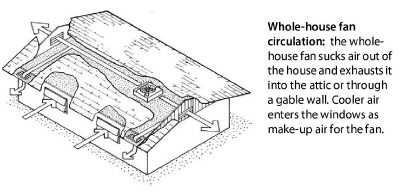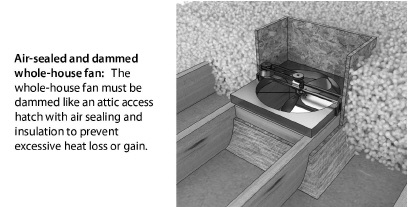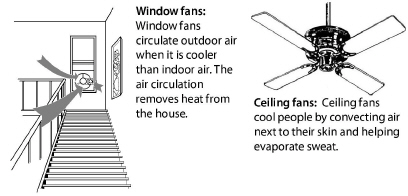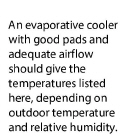
Ventilation cooled homes for centuries before air conditioning was invented. Ventilation is still an effective method for clients who can’t afford air conditioning.Ventilate with fans during the coolest parts of the day and night, and close the windows during the hottest periods.

Whole-house fans range in diameter from 24 inches to 42 inches, with capacities ranging from 3,000 to 10,000 cubic feet per minute (cfm). The capacity of the fan in cfm is rated for two different conditions: 1) free air; and 2) air constricted by 1 inch of static pressure. The second condition is closer to the actual operating conditions of the fan in a home, and the cfm rating at 1 inch of static pressure may still be 10 to 30 percent higher than the actual volume of air moved by the installed whole-house fan. This means you should probably install a fan with a greater capacity than the sizing recommendations that follow.
Whole-house fans require 2 to 4 times the normal area of attic vent openings. Install a minimum of 1 square foot of net free area for every 750 cfm of fan capacity. However, more vent area is better for optimal whole-house-fan performance because the extra vent area increases airflow.

To estimate the suitable size of a whole-house fan in cubic feet per minute, first determine the volume of your home in cubic feet. To calculate volume, multiply the square footage of the floor area in your home that you want to cool by the height from floor to ceiling. Take that volume and multiply by 15 to 40 air changes per hour, depending on how much ventilation you want. Then, divide by 60 minutes to get cubic feet per minute of capacity for the whole-house fan.

Some fans come with a tight-sealing winter cover. If the fan doesn’t have such a cover, or if the attic access doesn’t allow you to cover the fan easily, then you can fabricate a cover for the grille on the ceiling. A seasonal cover, held in place with rotating clips or spring clips and sealed with foam tape, works well. If the clients switch between air conditioning and cooling with a whole-house fan as the summer weather changes, build a tightly-sealed, hinged door for the fan opening that is easy to open and close when they switch cooling methods.

Window fans are best used in windows facing the prevailing wind or away from it to provide cross ventilation. Window fans can augment any breeze or create a breeze when the air is still. If the wind direction changes in your area, use reversible type window fans so you can either pull air into the home or push air out, depending on which way the wind is blowing. Experiment with positioning the fans in different windows to see which arrangement works best.

Air circulating fans are very effective cooling energy savers. Air circulating fans may allow a 4 degree rise in the thermostat setting with no decrease in comfort.
Use circulating fans with air conditioners, evaporative coolers, whole-house fans, or by themselves. Circulating fans save cooling energy by increasing air movement over the skin to help occupants feel cooler.
Ceiling fans and various types of portable fans provide more comfort at less cost than any other electrically powered cooling strategy. Options include: small personal fans that sit on tabletops, or heavier units that sit on the floor or on metal stands with wheels.
Ceiling fans produce high air speeds with less noise than oscillating fans or box fans. High quality ceiling fans are generally more effective and quieter than cheaper ones. Ceiling fans are a key element to providing low-cost comfort to a home.
|
SWS Detail: 3.1602.6 Capping Dual-Cooling Up-Ducts. 5.3003.8 Evaporative Cooler Maintenance and Repairs |
Evaporative coolers (also called swamp coolers) are an effective energy efficient cooling strategy in dry climates. An evaporative cooler is a blower and wetted pads installed in a compact louvered air handler.
Evaporative coolers employ different principles from air conditioners because they reduce air temperature without removing heat from the air. They work well only in climates where the summertime relative humidity remains less than 50%. They compare to an air conditioner with a SEER between 30 and 40, which is 2 to 3 times the SEER of the most efficient air conditioners.
Installers mount evaporative coolers on a roof, through a window or wall, or on the ground. The cooler can discharge air directly into a room or hall or it can be connected to ducts for distribution to numerous rooms.
.jpg)
The evaporative cooler’s blower moves outdoor air through water-saturated pads, reducing the air’s temperature to below the indoor air temperature. The blower moves this evaporatively cooled outdoor air into the house, pushing warmer indoor air out through open windows or dedicated up-ducts.
A water pump in the reservoir circulates water through tubes into a drip trough, which then drips water into the thick pads. A float valve connected to the home’s water supply keeps the reservoir supplied with fresh water to replace the water that evaporates.

Opening windows in occupied rooms, and closing windows in unoccupied rooms concentrates the cooling effect where residents need it. Experiment to find the right windows to open and how wide to open them. If the windows are open too wide hot air will enter. If the windows are not open far enough humidity will rise, and the air will feel sticky.
Up-Ducts
Up-ducts are one-way vents from the living space to the attic. Up-ducts are for occupants who want to avoid opening windows for security reasons. The cool air from the evaporative cooler flows into the living space, through the up-ducts, into the attic, and out the attic vents. Up-ducts can be a significant source of air leakage. They may be temporarily sealed seasonally or even removed during weatherization.
Evaporative Cooler Sizing and Selection
Evaporative coolers are rated in cubic feet per minute (cfm) of airflow they deliver. Airflow capacity ranges from 2000 to 7000 cfm. Recommendations vary from 2-to-3 cfm per square foot of floor space for warm dry climates and 3-to-4 cfm/sf for hot desert climates.
Evaporative Cooler Maintenance
Evaporative coolers see a lot of water, air, and dirt during operation. Dirt is the enemy of evaporative-cooler operation. Evaporative coolers process a lot of dirt because their aspen pads are good filters for dusty outdoor air.
Airborne dirt that sticks to the cooler pads washes into the reservoir. Most evaporative coolers have a bleed tube or a separate pump that changes the reservoir water during cooler operation to drain away dirty water. Evaporative coolers needs regular cleaning, depending on how long the cooler runs and how well the dirt-draining system is working. Be sure to disconnect the electricity to the unit before servicing or cleaning it.
Observe these general specifications for maintaining evaporative coolers.
ü Aspen pads can be soaked in soapy water to remove dirt. Clean louvers in the cooler cabinet when you clean or change pads. Replace the pads when they become un-absorbent, thin, or loaded with scale and entrained dirt.
ü If there is a bleed tube, check discharge rate by collecting water in a cup or beverage can. You should collect a cup in three minutes or a can in five minutes.
ü If the cooler has two pumps, one is a sump pump. The sump pump drains the sump every five to ten minutes of cooler operation.
ü If there is noticeable dirt on the blower’s blades, clean the blower.
ü Clean the holes in the drip trough that distributes the water to the pads.
ü Clean the reservoir every year to remove dirt, scale, and biological matter.
ü Pay particular attention to the intake area of the circulating pump during cleaning. Debris can get caught in the pump impeller and stop the pump.
ü Check the float assembly for positive shutoff of water when the sump reaches its level. Repair leaks and replace a leaky float valve.
ü Investigate signs of water leakage and repair water leaks.
|
Outdoor Relative Humidity % |
||||||||||||||||
|---|---|---|---|---|---|---|---|---|---|---|---|---|---|---|---|---|
|
|
|
2 |
5 |
10 |
15 |
20 |
25 |
30 |
35 |
40 |
45 |
50 |
55 |
60 |
65 |
70 |
|
Outdoor Temperature F˚ |
75 |
54 |
55 |
57 |
58 |
59 |
61 |
62 |
63 |
64 |
65 |
66 |
67 |
68 |
69 |
70 |
|
80 |
57 |
58 |
60 |
62 |
63 |
64 |
66 |
67 |
68 |
71 |
72 |
73 |
74 |
76 |
76 |
|
|
85 |
61 |
62 |
63 |
65 |
67 |
68 |
70 |
71 |
72 |
73 |
74 |
75 |
76 |
77 |
79 |
|
|
90 |
64 |
64 |
67 |
69 |
70 |
72 |
74 |
76 |
77 |
78 |
79 |
81 |
82 |
83 |
84 |
|
|
95 |
67 |
68 |
70 |
72 |
74 |
76 |
78 |
79 |
81 |
82 |
84 |
85 |
87 |
|
||
|
100 |
69 |
71 |
73 |
76 |
78 |
80 |
82 |
83 |
85 |
87 |
88 |
|
||||
|
105 |
72 |
74 |
77 |
79 |
81 |
84 |
86 |
88 |
89 |

|
||||||
|
110 |
75 |
77 |
80 |
83 |
85 |
87 |
90 |
92 |
|
|||||||
|
115 |
78 |
80 |
83 |
86 |
89 |
91 |
94 |
|
||||||||
|
120 |
81 |
83 |
86 |
90 |
93 |
95 |
|
|||||||||
|
125 |
83 |
86 |
90 |
93 |
96 |
|
||||||||||